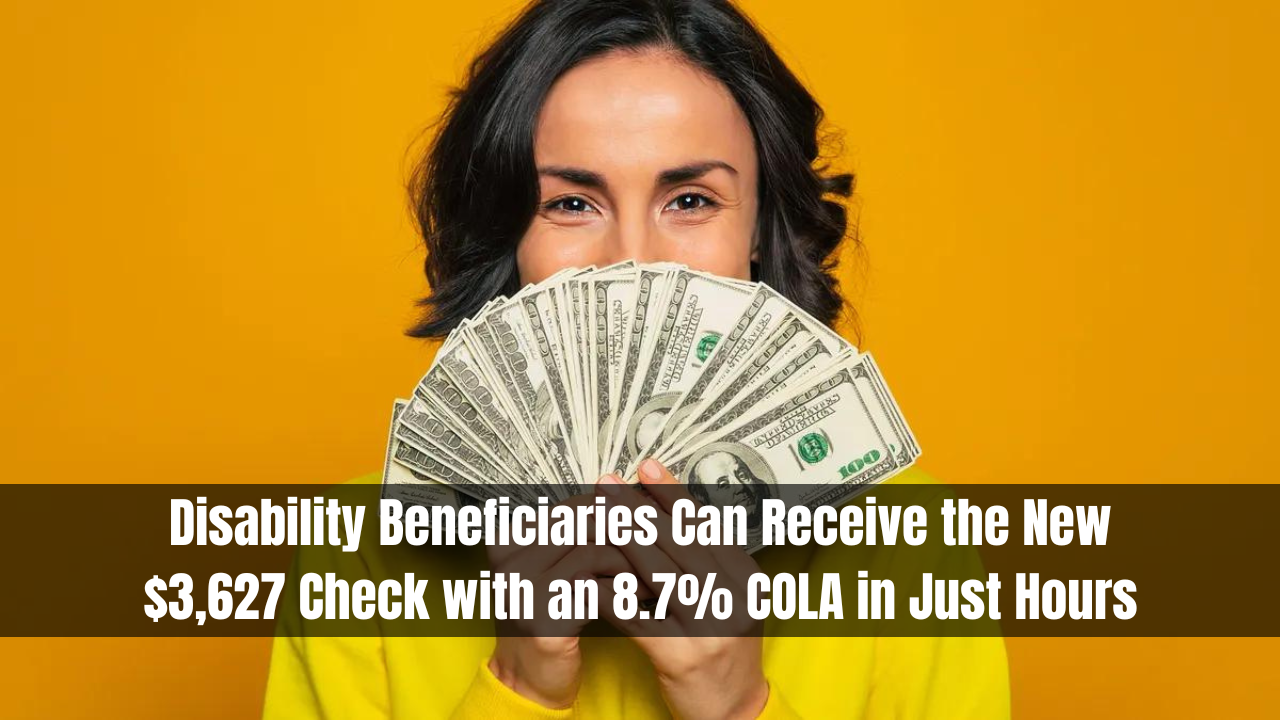Money
Disability Beneficiaries Can Receive the New $3,627 Check with an 8.7% COLA in Just Hours

Disability Beneficiaries Can Receive the New $3,627 Check with an 8.7% COLA in Just Hours. Retirees who receive Social Security Disability benefits can now secure up to $3,627 in just a matter of hours, thanks to an impressive 8.7% Cost of Living Adjustment (COLA) increase. To qualify for this substantial payment, certain requirements must be met.
Monthly Disability Benefit Payments
Each new month on the United States Social Security payment calendar marks the opportunity for Disability benefit recipients to receive a new check. Conversely, when a month comes to an end, the final recipients are also in line for a payment. The distribution of payments occurs on varying days, ensuring that every citizen receives their entitlement.
Read Als: Get Up to $400 in Free Money with the Stimulus Check in Virginia
Multiple Payments for Disability Beneficiaries
The Social Security Administration disburses up to four different checks to disability benefit retirees, with each payment tailored to specific beneficiary groups. This means not all Americans will receive all four checks. Typically, a disability beneficiary can receive a maximum of one retirement payment per month.
However, under certain circumstances, a retiree might receive two different payments in a month if Supplemental Security Income (SSI) comes into play. Furthermore, if there is an irregularity in the SSI payment schedule, the same retiree might receive up to three different payments, although these cases are exceptional.
Qualifying for the Next Payment
In the subsequent payment cycle, only the last group of retirees to receive their check will be eligible for it. It’s worth noting that having a disability check is not a prerequisite, as any type of Social Security benefit suffices to receive this payment. Meeting two specific requirements is all that’s necessary.
Requirements for Receiving the Disability Benefit Tomorrow
The maximum monthly payment of $3,627 for Social Security disability beneficiaries has reached this significant amount due to the 8.7% COLA adjustment for the current year. However, it’s important to note that this substantial COLA will not have the same impact on benefits starting in 2024. In the following year, the COLA will be reduced to 3.2%, a noteworthy decrease compared to 2023.
Regardless of whether a beneficiary receives the maximum $3,627 or a disability check of $1,200 per month, the Administration will issue the payment if two specific requirements are met.
The first requirement is having received the benefit after 1997, and the second is having a birthday falling between the 21st and 31st day of any month. These two requirements are pivotal and non-negotiable. Hence, one cannot collect the payment on a date like October 25th unless they fall into this group of retirees.
If these requirements aren’t met, the Social Security Administration may send payments on different dates, such as the 3rd, 11th, or 18th, depending on other factors. Nevertheless, if an accepted check is in place, the Administration will ensure it’s dispatched.
Can I Receive Social Security Old Age Retirement and SSDI?
It’s crucial to understand that one cannot simultaneously receive both Social Security Old Age Retirement and Social Security Disability Insurance (SSDI) payments. The reason for this is straightforward: receiving SSDI signifies retirement, making one ineligible to apply for Social Security Age Retirement benefits.
Once a retiree reaches the required age, their SSDI payment will seamlessly transition into Social Security Age Retirement payments. However, it’s essential to note that both payments won’t be disbursed concurrently; the SSDI payments will cease to make way for the Age Retirement benefits.
This transition does come with certain benefits, as SSDI payments are generally lower than Age Retirement payments. Ultimately, recipients will continue to receive a monthly check, but it will either be for Disability or Age Retirement, never both at the same time.

-

 UNISA News6 months ago
UNISA News6 months agoUniversity Applications For 2024 Are Now Open
-

 Blog6 months ago
Blog6 months agoUnisa Online Application 2024-2025 – www.unisa.ac.za
-

 UNISA News4 weeks ago
UNISA News4 weeks agoUNISA Courses in Teaching Foundation Phase
-

 UNISA News4 weeks ago
UNISA News4 weeks ago1 Year Diploma Courses at UNISA
-

 Blog4 weeks ago
Blog4 weeks agoUnisa Online Application 2024-2025 Apply Now
-

 UNISA News6 months ago
UNISA News6 months agoUNISA Closing Date for Registration 2024
-

 UNISA News4 weeks ago
UNISA News4 weeks agoCan I Do Diploma In Teaching At UNISA?
-

 UNISA News4 weeks ago
UNISA News4 weeks agoRE5 Certificate UNISA



















